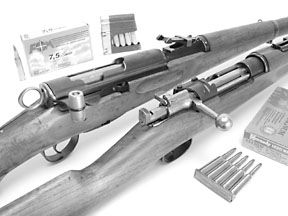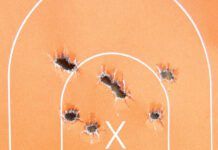
Due to their low cost and high quality, the Swedish M-96 Mauser and the Swiss K-31 have become popular with American gun owners. In fact, these two surplus guns have spawned a healthy aftermarket industry for upgrading them into sporters. This is a prime indicator of a gun’s desirability, since it’s unlikely that shooters would spend extra money making a sorry gun not quite as sorry.
The Swedish M-96 Mauser has been imported to the United States in large numbers since the early 1960s. About six years ago, the M-96 was selling for $50. SOG is currently selling them for $169, or more than a three-fold increase in their value over that span. Furthermore, the gun’s price may further increase because supplies seem to be drying up, partially because there were only 804,000 Swedish Mausers produced of all types. (German K98 Mausers numbered more than 11,500,000.)
Less available have been the Swiss K-31 rifles, which until recently have been imported only in small numbers. Also affecting their popularity has been ammunition issues: The ammunition has been expensive ($30 to $40 for 20 rounds) and difficult to find. Oddly, the Sweden-based Norma company is the only commercial producer of the 7.5 Schmidt Rubin (7.5x55mm) round fired in the K-31. SOG stocks 7.5 Swiss ammunition with non-corrosive Berdan-primed brass cases (196-grain match ammo) for $25.20 per 60 rounds or $192 for 480 rounds.
SOG is currently selling K-31s for $109, an amazing price considering some people have estimated that if the K-31 rifle was produced today, it would cost more than $2,000. Reason: All the parts are machined with tight tolerances. Every rifle was tested for accuracy, and the rifles were inspected on an annual basis. If a soldier’s rifle was found to have a bad bore due to improper cleaning, the barrel would be replaced at the soldier’s expense. Needless to say, the bores are generally in excellent condition.
But careful testing of other surplus firearms has taught us not to put too much stock into the reputation of a given gun. We have to see it for ourselves, so that’s just what we did.
Swedish M-96 Mauser 6.5x55mm, $169
The Swedish M-96 Mauser was manufactured by Mauserwerke in Obendorf (45,000 from 1899-1900), Carl Gustaf in Eskilstuna, Sweden (517,277 from 1898-1927), and Husqvarna Vapenfabriks in Husqvarna, Sweden (20,000 dating from 1940). The M-96 served the Swedish military until 1978, when it was retired.
It fires the 6.5x55mm Swedish Mauser round, the most common surplus version of which is the 139-grain boattail bullet. Velocity is around 2,592 fps in the M-96 rifle.
The muzzle end of the barrel on M-96 barrels is threaded. Screw-on flash suppressors can usually be found for $15 or less. The original purpose of the threading was to attach a blank firing adapter.
The M-96 uses a five-round internal magazine that can be reloaded with stripper clips. The 29.1-inch barrel has four grooves and a 1-in-7.9-inch twist. Several different types of wood were used for the stocks. Pictures and more information about the M-96 can be found at: <www.geocities.com/swede94/index.html>.
To enhance collector value and ensure the best fitting parts, check to see that all the serial numbers match on the M96. The full serial number is located on the receiver, barrel, and handguard. The last three digits of the serial number will be found on the bolt knob, firing pin, floor plate, bolt sleeve, cocking piece, ejector housing, bands, cleaning rod, trigger guard, and both pieces of the rear sight.
Another area to check includes a round brass disk on the bolt side of the stock. The disk indicates the bore diameter and the throat wear. The bore diameter is indicated by the triangle mark under the hundredths digit on the top portion of the disc. The throat wear is indicated in the lower right side of the disc. No triangle mark represents a new barrel. The 1 designates slight wear, 2 more wear, and 3 is the most wear permitted before barrel replacement. Some M-96 rifles have an older version of the brass disk that only indicates the unit and rifle numbers.
Some rifles have a square decal with two columns of numbers. The purpose of the decal is to provide the sight adjustments necessary to accurately shoot the newer Model 1941 139-grain ammunition instead of the Model 1894 156-grain ammunition that the sights were originally designed for. The left column labeled “Avstand” is the “Range” and the right column labeled “Sikte/rp” is the setting for your sight and adjustment. The lowest setting on the sights is 300 meters, so when you are shooting at 100 meters you have to aim 11.2 inches low to strike center. When the rear sight lays horizontal, it can be adjusted from 300 to 600 meters. When it is stood up vertically, it can be adjusted from 700 to 2,000 meters. If the rear sight is replaced with a Mojo aperture rear sight, then you can achieve point of aim at 100 yards. In our view, the Mojo aperture rear sight, available at www.mojosights.comfor only $29, is a must-have item for this rifle.
[PDFCAP(2)]Several companies make aftermarket accessories for the M-96. An adjustable target trigger is available from Timney Triggers for $43.60 (SP M91-4), which fits Mausers with the original military stock that cock on closing the bolt. It features a fully adjustable, 2- to 4-pound trigger-pull weight. Synthetic stocks are available from Ramline.
Our sample had a reddish-brown wood stock that was in mostly good shape. There was some pitting on the buttstock, but the forearm was in very good shape, with most of the finish intact. The barrel was in excellent condition, as revealed by a Hawkeye borescope. The bolt operated smoothly, and the sights were in good condition, though the rear notch was very brief and hard to use, as noted above. The metalwork showed only light blueing wear, and the muzzle was in good shape, with no dings that we could see. The Swede had a straighter, thinner grip than the Swiss, and we preferred the handfit of the latter gun.
Swiss Schmidt Rubin K-31 7.5 Swiss, $109
The Swiss Model 1931 rifle is an improvement of the Swiss Model 1911 rifle. Both rifles are of the straight pull design, but the locking lugs are on the rear of the bolt on the 1911 model and on the front of the bolt on the K-31. The new design of the K-31 bolt had two major advantages over the prior 1911 design. It was far stronger and had half the bolt-throw length of the M1911. The K31 was produced from 1933 to 1958, and 528,180 were made. The K-31 shoots the 7.5x55mm Swiss round.
The rifle uses a four-groove, right-hand-twist barrel and a six-shot detachable-box magazine. Spare magazines are rare. The rifle can be loaded with stripper clips. If the butt plate is removed, the soldier’s name and unit are sometimes written there.
In our sample, the two-stage trigger had a fair bit of take up in the first stage, but the second stage was nearly as good as a match trigger. The butt on our sample was pretty chewed up, but it didn’t affect the operation of the gun. As a collectible, we’d leave it as is, of course, but if we were going to use it, we would refinish the stock. The forend showed some darkening from hand oils, dirt, and who knows what else. The metalwork was in generally good condition, but there was the expected blueing wear along the edges of the trigger guard and the muzzle.
What was particularly interesting to us was the operation of the bolt, which features a handle, that when pulled straight back, unlocks the bolt and allows the mechanism to cycle. Though it’s disconcerting to see the circular, exposed ring on the firing pin coming back toward the eye, it was easy to pull the bolt handle rearward, shove it forward, and hold the gun on or near the target. Also, we suppose the gun could be carried with a round in the chamber and the bolt uncocked. It would be simple and fast to pull the cocking pin back manually and fire the first round.
The front sight is hard to read in low light conditions, and not all that great in good light. We would add a Mojo aperture rear sight for $29. The sight requires no gunsmith work and the original sight can be put back on to retain collector value. An excellent source for further information and accessories for the K-31 and Swiss rifles in general can be found at Lee Erstman’s web site at www.swissrifles.com.
Gun Tests Recommends
Swiss Schmidt Rubin K-31 7.5 Swiss, $109 (dealer). Our Pick. We like the Swiss rifle a little better than the Swedish one because of the straight-pull bolt on the Swiss model. We also prefer the six-round magazine of the K31 to that of the five-round M-96. The K-31 is nearly as heavy as the M-96, but it is 5.5 inches shorter. The K-31 is also $60 cheaper. The M96 has a wider range of ammunition available in 6.5x55mm than does the K-31’s 7.5x55mm cartridge, but if you are a handloader it does not matter because the 7.5 round uses .308 caliber bullets just the same as the 7.62 NATO round.
Swedish M-96 Mauser 6.5x55mm, $169. Buy It. Our sample was an accurate, easy-to-use rifle that has both practical and historical appeal. If we found a good sample, we wouldn’t hesitate to add it to our collection.

















